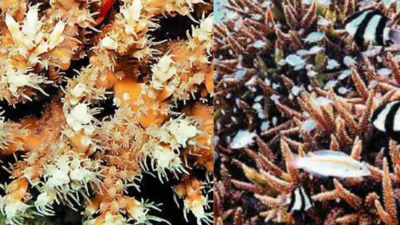- News
- City News
- kochi News
- Lakshadweep coral reefs face bleaching threat
Trending
This story is from May 3, 2024
Lakshadweep coral reefs face bleaching threat
Lakshadweep reefs suffer 25% coral cover decline from mass bleaching. Researchers warn of past bleaching impacts and emphasize a 6-7 year recovery period. Similar bleaching signs observed in Gulf of Mannar.

Acropora, a coral species, found in the Lakshadweep archipelago. When bleaching occurs the corals lose colours and turn pale (r)
They emphasize that Lakshadweep reefs can recover, but it takes 6-7 years without further disturbances for recovery to be noticeable.

This alert confirmed a global bleaching event active across the tropics, linked to increased global sea surface temperatures due to prolonged El Nino conditions throughout much of 2023.
Researchers in Lakshadweep are now recording widespread coral stress as shallow water temperatures are 1.6°C above the seasonal average. Corals are turning pale or white, with tissue wasting and death becoming increasingly common.
"Over a large part of 2023 and 2024, the temperatures have been pretty high in this region. While the corals are not dead, about 80% are showing bleaching signs. Some corals have turned completely white, others are dying, and some exhibit a fluorescent colour as an adaptation to reflect sunlight and reduce temperature-induced stress," said Wenzel Pinto, an NCF researcher. Pinto has been monitoring the reefs on the islands since December, particularly in Kavaratti, and notes similar symptoms in the waters of Kadmat.
Researchers have been monitoring the four coral regions of the country, including the Gulf of Mannar on the mainland, and the corals here are also showing signs of bleaching, said K Diraviya Raj, associate professor, Suganthi Devadason Marine Research Institute, Chennai.
A CRW alert level -2 was issued for both Lakshadweep and the Gulf of Mannar in December, said Raj, who has studied the Gulf of Mannar's corals for years. "The corals can recover if temperatures decrease by 1-2 degrees in the following two months. However, this year, the temperatures have remained high for an extended period," he said. "Losing coral on reefs is akin to losing trees in a rainforest", said Mayukh Dey of NCF, highlighting the gravity of the situation.
End of Article
FOLLOW US ON SOCIAL MEDIA











